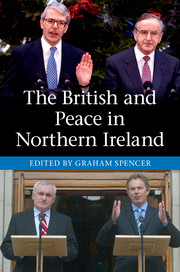Book contents
- Frontmatter
- Dedication
- Contents
- Notes on contributors
- Acknowledgements
- Brief chronology of the peace process
- Abbreviations
- Key documents
- Introduction
- 1 The terrain of discourse
- 2 The Anglo-Irish Agreement: an interview with Sir David Goodall and Lord Armstrong of Ilminster
- 3 The constitutional issue in Irish politics
- 4 Negotiations and positions: an interview with Sir John Chilcot
- 5 Resolving intercommunal conflict: some enabling factors
- 6 Tactics, strategy and space
- 7 The Joint Declaration and memory
- 8 Movement and transition in 1997: Major to Blair
- 9 The challenge of symmetry in dialogue: an interview with Sir Joseph Pilling
- 10 Why was the Good Friday Agreement so hard to implement?: lessons from ‘Groundhog Day’, 1998–2002
- 11 Text and context: an interview with William Fittall
- 12 The nature of dialogue: an interview with Sir Jonathan Phillips
- 13 Managing the tensions of difference: an interview with Jonathan Powell
- Conclusion
- Index
- References
2 - The Anglo-Irish Agreement: an interview with Sir David Goodall and Lord Armstrong of Ilminster
Published online by Cambridge University Press: 05 March 2015
- Frontmatter
- Dedication
- Contents
- Notes on contributors
- Acknowledgements
- Brief chronology of the peace process
- Abbreviations
- Key documents
- Introduction
- 1 The terrain of discourse
- 2 The Anglo-Irish Agreement: an interview with Sir David Goodall and Lord Armstrong of Ilminster
- 3 The constitutional issue in Irish politics
- 4 Negotiations and positions: an interview with Sir John Chilcot
- 5 Resolving intercommunal conflict: some enabling factors
- 6 Tactics, strategy and space
- 7 The Joint Declaration and memory
- 8 Movement and transition in 1997: Major to Blair
- 9 The challenge of symmetry in dialogue: an interview with Sir Joseph Pilling
- 10 Why was the Good Friday Agreement so hard to implement?: lessons from ‘Groundhog Day’, 1998–2002
- 11 Text and context: an interview with William Fittall
- 12 The nature of dialogue: an interview with Sir Jonathan Phillips
- 13 Managing the tensions of difference: an interview with Jonathan Powell
- Conclusion
- Index
- References
Summary
Background
The Anglo-Irish Agreement (AIA), negotiated and signed by the British and Irish governments on 15 November 1985, has been viewed as a moment of history that ‘ushered in an era of direct rule with a green tinge’, and, because of this, ‘sent a shudder of horror through the unionist community’ (Bew and Gillespie 1999: 190–1). The preamble to the Agreement emphasised collaboration and cooperation between Ireland and the United Kingdom in the context of the European Union, which required the two governments to work as ‘neighbours and partners’. That cooperation was directed, in particular, at the need to try to reduce division and ‘achieve lasting peace and stability’. Significantly, the Agreement stressed a requirement to reconcile the rights of the different traditions ‘represented, on the one hand, by those who wish for no change in the present status of Northern Ireland and, on the other hand, by those who aspire to a sovereign united Ireland achieved by peaceful means and through agreement’. Adhering to an approach already expressed in the Sunningdale Agreement (SA), Article 1 of the Agreement underlined that any change in the status of Northern Ireland could come about only with the consent of the majority of people who lived there. It affirmed that since the majority wished for no change in that status, Northern Ireland would remain part of the United Kingdom. But (and this would provoke the fear of unionists) ‘if in the future a majority of the people of Northern Ireland clearly wish for and formally consent to the establishment of a united Ireland’ the two governments ‘will introduce and support in the respective Parliaments legislation to give effect to that wish’. The framework used to facilitate this possibility, and allow the Irish a consultative role in Northern Ireland's affairs, would take the form of an Intergovernmental Conference, set up to deal with political, security and legal matters, the administration of justice and the promotion of cross-border cooperation.
- Type
- Chapter
- Information
- The British and Peace in Northern IrelandThe Process and Practice of Reaching Agreement, pp. 33 - 54Publisher: Cambridge University PressPrint publication year: 2015



